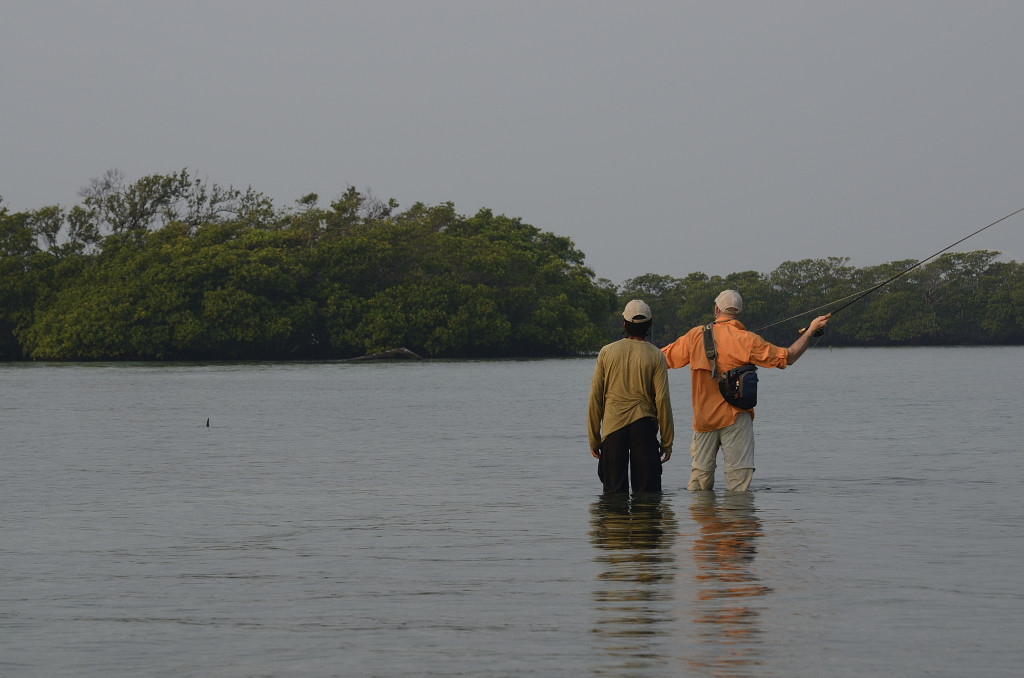Jan, 2016: Many of you have trips planned over the next several months to Mexico and Belize with the goal of catching a permit on a fly. A permit is undoubtedly the most difficult fish to catch on the flats. However, they are still catchable and you don’t have to be an expert to do so. Here are a few tips to help you check this species off your bucket list.
Catching a permit versus a bonefish requires completely different tactics. While bonefishing calls for short steady strips in most cases, permit fishing does not. A permit’s favorite food is tiny crabs. So your fly should mimic the behavior of a crab. Crabs, when in danger, don’t go skipping and skittering across the bottom. They lie still to prevent from being seen or they bury themselves in the sand hoping to survive another day.
Once a permit is spotted, similar to bonefish, you want to lead the fish so your cast doesn’t spook them. How far to lead is a difficult question to answer as every permit will react differently. If the permit is tailing (head down and tail up) then he’s eating. In these cases, you can almost hit the permit on the head without spooking him. Otherwise your goal is to have the permit either hear or see your fly. Since permit swim very erratically in all directions, casting can be difficult as well. Stay calm and make your best cast that doesn’t spook the fish.
After your fly lands and sinks to the bottom, if the permit doesn’t move towards your fly, what do you do? If he does, what do you do?
If the permit ignores your fly, he obviously hasn’t seen it. Thus you want to make a series of long slow 2 – 3 foot strips until the fly catches his attention. I can’t emphasize enough the need for long slow strip. If he reacts and rushes to your fly, stop! Do nothing! Let the permit decide your next move. As I mentioned above, the permit is eating when his head goes down and the tail goes up. If your line and leader are tight to the fly, you may feel him eat. Otherwise very, very slowly strip and if you feel resistance, set the hook with a long – this is extremely important – fly line strip set. Do not do a rod set like you would do with a trout. It’s a hard habit to break in all the excitement for freshwater fishermen. However, a strip set will keep the fly in the area of the permit whereas a rod set will lift the fly away from the fish and would likely spook him. If he doesn’t eat and starts to swim away, he can’t find your fly. Try another series of long slow strips or you may have to make another cast depending on how he is reacting. Your guide will let you know. Again, if he responds and rushes to the area of your fly – stop – and see how he reacts. If he doesn’t respond or follows the fly without eating only to veer off and swim away, welcome to the club. Keep on trying! That’s permit fishing!
Let’s talk flies and leaders. More permit are caught on crabs than any other fly. From my experience, you want a selection of crab patterns to cover the conditions you may see on the flats. A selection of mostly lead eye flies for deeper water with a few bead chain eyes for shallow water. Size 4 and 6 are most popular, but a few in sizes 2 and 8 would make a complete permit fly box. As for color, I don’t think the color is as important as the presentation. Try to match the bottom color whenever possible. I’ve had my best success with light tan, closer to white than tan, but I always want a few olive and tan patterns as well. Other patterns such as the Squimp, Veverka’s Mantis Shrimp, Clouser Minnows, and a host of other flies more known for catching bonefish have caught their share of permit. Your leader is also very important. My typical permit leader is a 9 foot, 16 pound mono leader to which I attach a 3 foot section of 16 pound fluorocarbon tippet. On windy days I shorten my leader if conditions call for it.
Casting is also very important. Not so much as distance, but accuracy and a quick delivery. Learn the double haul cast for those windy days. Practice limiting your false casts to one, two at the most. I’ve seen guys do multiple false casts and by the time the fly hits the water the fish is long gone. Remember, long slow strips to get their attention and then stop and let the permit decide what you need to do next.
For those traveling, good luck on your trip and let me know on your return if you checked the permit off your bucket list using these techniques.
Should you have any questions or want to discuss the above in more detail, please feel free to contact me at your convenience. Thanks and remember….Fish Hard!
By: Bob Artzberger, Mexico and Seychelles Destination Specialist





